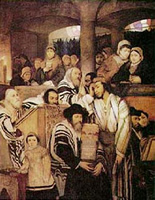 |
Day
of Atonement Maurycy Gottlieb, 1877 |
The
Lord said to Moses, “The tenth day of this
seventh month is the Day of Atonement.
Hold a sacred assembly and deny yourselves, and
present an offering made to the Lord by fire.
Do no work on that day, because
it is the Day of Atonement,
when atonement is made for you before the Lord
your God.”
(Leviticus 23:26-28)
The most important holiday of the Jewish year is Yom Kippur, the ‘Day of Atonement’, which occurs on the 10th day of the month of Tishri; it is a day set aside to “afflict the soul”—i.e. to atone for the sins of the year. Work is not permitted, most of the day is spent in the synagogue and believers are encouraged to fast. It is also customary to wear white as a symbol of purity; some participants wear a kittel to the Yom Kippur service, the white robe in which the dead are buried.
The first service of Yom Kippur begins with the Kol Nidre (‘all vows’), a prayer in which the petitioner asks God to annul all personal vows they may make in the coming year. There has been endless debate about the origin and meaning of the Kol Nidre, and anti-Semites have held it up as proof of Jewish untrustworthiness. However the prayer has a long history in the liturgy dating to at least the 9th century CE, and when sung by the cantor it has a profound effect on the congregation.
As the sun is going down during the final service of the festival, a prayer known as Neilah (‘closing’) is said, a reference to the closing of the gates of prayer. At the end of this service the shofar is blown for the final time, bringing to a close the ten day period known as the days of awe.
For
more see Days
of awe and atonement